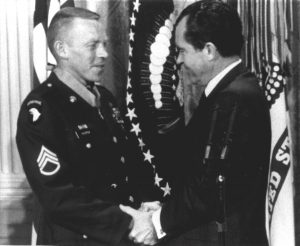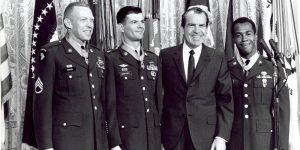Joe Ronnie Hooper of Moses Lake, Washington, is without a doubt the most decorated veteran of the Vietnam War. Awarded a total of thirty five decorations including: two Silver Stars, six Bronze Stars, eight Purple Hearts and the Congressional Medal of Honor (MOH) – incredibly his tally even exceeds that of the legendary Audie Murphy.


Hooper’s military career began in 1956 when he did a four year stint in the US Navy. By 1960, one year after leaving the Navy, Joe decided to join the Army and served until 1978, retiring as a Captain. During his time as a squad leader in the 501 Infantry, 101 Airborne Division, he was recommended for America’s highest award for his actions on February 21, 1968, outside Hue , Vietnam.
One of Hooper’s personal heroes was Pfc Joe E Mann (502 PIR, 101 Airborne Division). Just like Hooper, Mann was a soldier from Washington but who grew up in Reardon, and just like Hooper, Mann was also awarded the MOH but posthumously in WWII during Operation Market-Garden. Close to the Dutch town of Best near the Wilhelmina Canal, Joe Mann was laying wounded with both arms bandaged and strapped across his chest when a German grenade landed in his foxhole. In a split second decision Mann launched himself onto the explosive and sacrificed his own life to save his comrades.

Joe E Mann
After the war, a group of locals erected the “Joe Mann Monument”, a tri-paneled base showing the battle topped with the model of a mother pelican sacrificing blood from her own chest to feed her babies. The mother pelican is rooted in ancient legend and symbolism. In time of famine, using her beak, the Pelican pierced her own breast to feed her young preventing them from starvation. Another version of the legend states that the mother fed her starving babies with her own blood to revive them from death but in turn sacrificed her own life.
Hooper felt a special connection to Mann, as apart from sharing the same christian name, both were from Washington and both served with the 101st Airborne Division. As a boy, while still in High School after reading about Mann, Hooper wrote an essay about the Medal of Honor, focusing on Pfc Mann. The young Joe Hooper made several trips to Reardon to collect newspaper clippings to document the story.

In September 1969, Joe made a trip to represent his former unit during the 25th Anniversary of the liberation of the Netherlands. During that visit, alone Joe went to the “Pelican Monument” and paid his respects before climbing one of the four supporting pillars and attached his own MOH just below the pelican, “he sacrificed himself – I didn’t”, Joe later said. The following day when officials unveiled the monument, despite their obvious delight, the medal caught everyone by complete surprise. After being informed that it was not safe, Hooper retrieved his medal, and at the request of the Queen, deposited the award at Best – where it is still kept today.
After returning the USA, Captain Hooper applied for and was granted a replacement medal, which he later exchanged for another due to the fact that it did not have the traditional green enamel inset on the rays eminating from the star. Joe lived a turbulent life and sadly passed away at the age of 40 in 1979.
A True Soldier and war hero !






